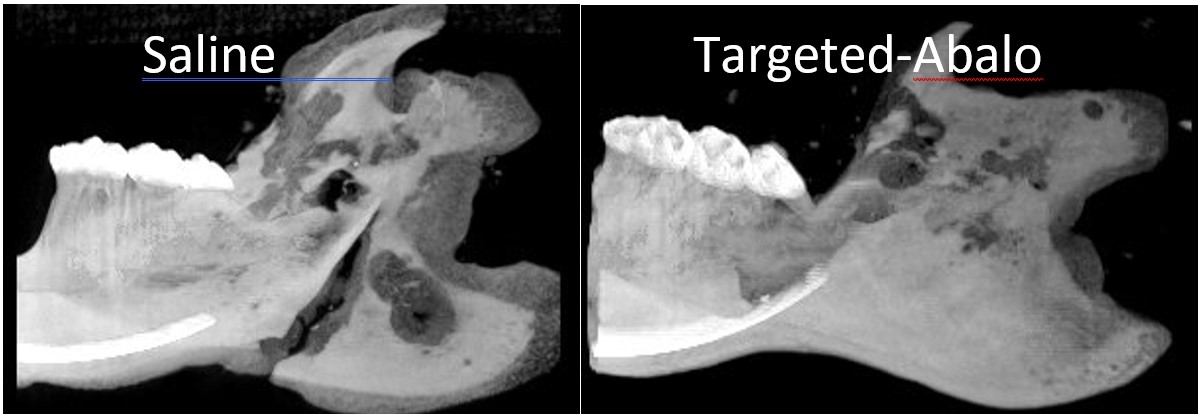IADR Abstract Archives
Re-engineering Abaloparatide to Selectively Accumulate and Heal Mandibular Osteotomies
Objectives: We have developed a fracture-targeted bone anabolic agent that is both potent and shows no toxicities near the therapeutic range. Following systemic injection, the targeted bone anabolic accumulates selectively on a bone fracture, osteotomy, or graft surface and improves the rate of bone repair as well as the quality of the bone deposited. By selectively targeting the fracture itself, we avoid invasive surgery and ectopic bone growth associated with the application of local anabolic agents. The systemic administration also provides an opportunity to deliver multiple doses, sustaining the stimulation during specified stages of the healing process.
Methods: To achieve the above objective, we synthesized an engineered fragment of parathyroid hormone-related protein fragment. On the C-terminus we conjugated a bone mineral-(hydroxyapatite-) targeting acidic oligopeptide forming targeted-Abalo. The negatively charged oligopeptide gives targeted-Abalo a remarkable specificity and homing ability towards raw hydroxyapatite.
In vivo experiments were conducted on Sprague Dawley rats (n=6). An osteotomy was cut from the sigmoid notch
down to the ventral border of the mandible and was stabilized with a microplate. Rats were administered (S.C.) targeted-Abalo (6nmol/kg/dose) or saline b.i.w. for three weeks. After three weeks, rats were euthanized, mandibles excised and analyzed using microCT followed by mechanical force testing.
Results: By 3 weeks post surgery, dramatic improvements were observed in the reduction of the osteotomy gap where the diameter of the treated group’s gap was 13% of the diameter of the saline control (p<0.01). The microarchitecture was also improved. In the treated group, the structure of the bone had remodeled to nearly normal bone whereas an obvious gap was still present in the saline groups. Finally, and likely the most important data is that the maximum load that the treated jaws could withstand prior to failure was 2.7 fold that of saline (p<0.5) and when they were compared to the strength of the contralateral jaw, it was found that they had returned to the strength of non-broken bone.
Conclusions: Maxillofacial bone repair dramatically reduces quality of life during the healing process. Accelerating that repair with targeted-abalo could help reduce the burden on the patient.
Methods: To achieve the above objective, we synthesized an engineered fragment of parathyroid hormone-related protein fragment. On the C-terminus we conjugated a bone mineral-(hydroxyapatite-) targeting acidic oligopeptide forming targeted-Abalo. The negatively charged oligopeptide gives targeted-Abalo a remarkable specificity and homing ability towards raw hydroxyapatite.
In vivo experiments were conducted on Sprague Dawley rats (n=6). An osteotomy was cut from the sigmoid notch
down to the ventral border of the mandible and was stabilized with a microplate. Rats were administered (S.C.) targeted-Abalo (6nmol/kg/dose) or saline b.i.w. for three weeks. After three weeks, rats were euthanized, mandibles excised and analyzed using microCT followed by mechanical force testing.
Results: By 3 weeks post surgery, dramatic improvements were observed in the reduction of the osteotomy gap where the diameter of the treated group’s gap was 13% of the diameter of the saline control (p<0.01). The microarchitecture was also improved. In the treated group, the structure of the bone had remodeled to nearly normal bone whereas an obvious gap was still present in the saline groups. Finally, and likely the most important data is that the maximum load that the treated jaws could withstand prior to failure was 2.7 fold that of saline (p<0.5) and when they were compared to the strength of the contralateral jaw, it was found that they had returned to the strength of non-broken bone.
Conclusions: Maxillofacial bone repair dramatically reduces quality of life during the healing process. Accelerating that repair with targeted-abalo could help reduce the burden on the patient.

